Use your widget sidebars in the admin Design tab to change this little blurb here. Add the text widget to the Blurb Sidebar!
Posted: March 16th, 2010 | Author: nat | Filed under: project | No Comments »
Part-time Suite started its project in 2009, first by looking for places in the city.
We go through places actually affordable to us, and then rent for a short period the place we have found. Not owning the place, we have physical and practical restrictions which we amplify and convert into lyrical features of our work. In order to escape from the restriction, for the three past projects – at a basement, a vacant lot and a roof top – we simply accepted all the restrictions (in Under Interior), let them be as we took a loophole (in off-off-stage) or stood on them, threw a question pointed toward the destiny of the collective itself (in Loop the Loop). Through those kinds of processes we turn the spatiality of the place into something sensuous and tangible, stimulating the place to reveal by itself its identity which has been neglected. The audience who has decided to enter – by taking off his/her shoes, by blocking outside sounds to make his/her hearing acute – will witness by senses, rather than speculate, the place’s raison d’être and remember he/she can come across the place once and again, anytime in the city.
Part-time Suite, collaboration group of Miyeon Lee, Byungjae Lee and Jaeyoung Park who graduated Art school in February. 2009, was founded on April 2009 and based in Seoul, Korea. It undertook three projects, “Under Interior” in a basement at Chungjeongro in June, “off-off-stage” at an unoccupied lot in the center of the city, Shinmunro, in September and “Loop the Loop” at a roof-top at Yeonjidong in December, all under the sponsorship of Art Council Korea, issued 2009. The last project was a part of the exhibition “Perspective Strikes Back” presented by Hyunjin Kim at Doosan Art Center. The group is bound together on mutual trust between the members while accepting each other’s singularity and individuality. Our works develop during and from frequent meeting and talk session. Each member is also working on his/her own projects.
Updated in Mar/2010
text frrom http://www.parttimesuite.org
Posted: March 16th, 2010 | Author: nat | Filed under: paper | Tags: 김장언 ê³µê³µë¯¸ìˆ | No Comments »
ìƒì§•ê³¼ 소통 – 지금 í•œêµì—ì„œ ê³µê³µë¯¸ìˆ ì€ ì–´ë””ì— ìœ„ì¹˜í•˜ê³ ìžˆëŠ”ê°€?
김장언
êµë¬¸ìš”약Â
ì´ ë…¼ë¬¸ì€ 2천년대 ì´í›„ ì •ë¶€ 주ë„ë¡œ ì§„í–‰ëœ ê³µê³µë¯¸ìˆ í”„ë¡œì 트가 ì‹ ìžìœ 주ì˜ì ë¬¸í™”ì „ëžµì˜ í•˜ë‚˜ë¡œ 기íšëœ 문화 ì´ë²¤íŠ¸ìž„ì„ ê°€ì •í•˜ê³ , ê·¸ 기ì›ê³¼ íë¦„ì„ íŒŒì•…í•˜ê¸° 위해서 í•´ë°© ì´í›„ í•œêµì˜ 공공 ë¯¸ìˆ í”„ë¡œì íŠ¸ì˜ ë§¥ë½ê³¼ ì—사를 비íŒì 으로 분ì„한다. 공공 ë¯¸ìˆ ì€ ì‹œê°„ê³¼ ê³µê°„ì„ ë– ë‚˜ì„œ ì–¸ì œë‚˜ ë…¼ìŸì ì¸ ì´ìŠˆë¥¼ ìƒì‚°í•´ 왔다. í•œêµì—ì„œ ì—ì‹œ 공공 ë¯¸ìˆ ì€ ë¯¸ìˆ ê³„ ë¿ë§Œ ì•„ë‹ˆë¼ ì‚¬íšŒì 으로 다양한 ë…¼ìŸê³¼ ì´ìŠˆë¥¼ ìƒì‚°í•´ 왔다. 그러나 ì´ëŸ¬í•œ ë…¼ìŸë“¤ì€ 개별 공공 ë¯¸ìˆ í”„ë¡œì íŠ¸ì˜ ë¯¸í•™ì ì˜ˆìˆ ì 성취를 ì •ë‹¹í™”í•˜ëŠ”ë° ì§‘ì¤‘í•¨ìœ¼ë¡œì¨ ê³µê³µë¯¸ìˆ í”„ë¡œì 트가 가능하게 ë˜ëŠ” ì •ì¹˜ 사회 문화ì 맥ë½ì„ 간과하게 하는 ìƒí™©ì— 놓여졌다. ë”°ë¼ì„œ ì´ ë…¼ë¬¸ì€ í•œêµì˜ ì •ì¹˜ 사회ì 변화 ì†ì—ì„œ ê³µê³µë¯¸ìˆ ê°œë…ì´ ì–´ë–»ê²Œ 발명ë˜ë©° ì „ìœ ë˜ëŠ”지를 추ì í•˜ê³ ìž í–ˆë‹¤. ì´ëŸ¬í•œ ê³¼ì •ì—ì„œ ì´ ë…¼ë¬¸ì´ ê°€ìž¥ 주목하는 지ì ì€ 1987ë…„ 6ì›” í•ìŸ ì´í›„ ì•¼ê¸°ëœ í•œêµ ì‚¬íšŒì˜ ë¯¼ì£¼ì£¼ì˜ í™•ëŒ€ì™€ 1997ë…„ IMF êµ¬ì œ 금융 ì´í›„ 급ì†ì´ ë„ìž…ëœ ì‹ ìžìœ ì£¼ì˜ ì²´ì œ ì†ì—ì„œ 공공 ë¯¸ìˆ ì´ ì–´ë–»ê²Œ í•œêµ ì‚¬íšŒ ì†ì— ì¸ì‹ë˜ê³ ìž‘ë™ë˜ì—ˆëŠ”ì§€ì— ê´€í•œ 것ì´ë‹¤. 1987ë…„ê³¼ 1997ë…„ì„ ì£¼ëª©í•˜ëŠ” ê²ƒì€ ì´ ë‘ ì‚¬ê±´ì´ í•œêµ ì‚¬íšŒì˜ ë³€ë™ê³¼ ì„±ê²©ì„ ê·œì •í•œ ìƒì§•ì 사건으로 ì¸ì‹í•˜ê¸° 때문ì´ë‹¤. êµê°€ 만들기 ê³¼ì •ì—ì„œ ë¯¼ì£¼ì£¼ì˜ í™•ëŒ€ ê·¸ë¦¬ê³ ì‹ ìžìœ ì£¼ì˜ ë„ìž…ê³¼ 확대ë¼ëŠ” í° í‹€ì—ì„œ 공공 ë¯¸ìˆ ì´ ì–´ë–»ê²Œ ì •ë¶€ì— ì˜í•´ì„œ 초대ë˜ë©°, ë¯¸ìˆ ê³„ì— ì˜í•´ì„œ ì „ìœ ë˜ê³ , í•œ 사회 ì†ì—ì„œ ìž‘ë™ë˜ì—ˆëŠ”지를 ì´ ë…¼ë¬¸ì€ ë¹„íŒì 으로 분ì„한다. ê·¸ë¦¬ê³ 2천년대 ì´í›„ ì •ë¶€ 주ë„ë¡œ ì§„í–‰ëœ ê·¸ë¦¬ê³ í˜„ìž¬ 진행ë˜ê³ 있는 ê³µê³µë¯¸ìˆ í”„ë¡œì 트가 ì‹ ìžìœ 주ì˜ì ë¬¸í™”ì „ëžµìœ¼ë¡œ 어떻게 ìš°ë¦¬ì˜ ì¼ìƒì—ì„œ ìž‘ë™ë˜ê³ 우리를 í†µì œí•˜ê³ ìžˆëŠ”ì§€ë¥¼ ‘ìƒì§•(symbols)’과 ‘소통(communication)’ì´ë¼ëŠ” ê°œë…으로 ë…¼ì˜í•œë‹¤.Â
Â
주요어
ê³µê³µë¯¸ìˆ , 공공성, ì‹ ìžìœ 주ì˜, ë¬¸í™”ì „ëžµ, 광화문 광장, ìƒì •ì¹˜
———————————-
ABSTRACT
Symbol and Communication: Where is the public art located in S. Korea?
JANG UN KIM independent curator / art critic
Â
This paper is intended to criticize the history and context of the public art projects at South Korea since 1945 in order to analyze the birth and the changes of Korean public art on the assumption that the most of the public art projects organized and hosted by the national and local governments after 2000 are the one of the cultural events structured as the cultural strategies and policies in the Neoliberal era. Public art is always aroused controversy beyond time and space; likewise, public art in the Korean context has been provoking argument and discussion socially and culturally. But the most of the arguments and issues only deal with the aesthetic and artistic achievements of the individual projects, and therefore could not explain the socio-political context related with the public art projects. So, this paper is intended to analyze how the meaning of the public art has been invented and articulated under the socio-economic and political changes of South Korea. In the process of the research, this paper concentrates attention on two points in time of the Korean contemporary history; one is the year 1987 and the other is the year 1997. The 1987 Democratization Movement brought about the changes of the political system and the 1997 financial crisis imposed Neo-liberalism on Korean society. These symbolic events changed and transformed its characters. So this paper critically analyzes how public art is invited by the government, articulated by the Korean contemporary art scene and activated in the communities under tree historical moments; Nation-state building, the spread of democracy and the imposition of neo-liberalism. And this paper will argue that public art has been effectively abused as one of the cultural strategies of government in the Neo-liberal Era and activated to control our everyday-lives under the concept of ‘symbols’ and ‘communication’ by the government.
See the 김장언-비주얼ì›ê³ (e-seoulìš©) text only in Korean
Posted: March 11th, 2010 | Author: nat | Filed under: architecture | No Comments »

The architect for Nam June Paik Art Center was selected among 430 participants in an international competition endorsed by the International Union of Artists (UIA) in 2003. The prize winning entry by Kirsten Schemel, a young German architect, who was commissioned together with Marina Stankovic in KSMS Schemel Stankovic Architects (Berlin) to design the building shown below. Characteristic of the museum is its screen facade consisting of several layers of reflective and partly printed glass. The building contains exhibition halls, video archive, multi-purpose hall, etc. The Nam June Paik Art Center has a total area of 5,600sqm (60,300sft) of which three stories are above ground and two stories underground. It was presented to the public at the completion ceremony on April 30, 2008
Text from http://www.njpartcenter.kr/
Posted: March 11th, 2010 | Author: nat | Filed under: architecture | No Comments »
Architectural Concept
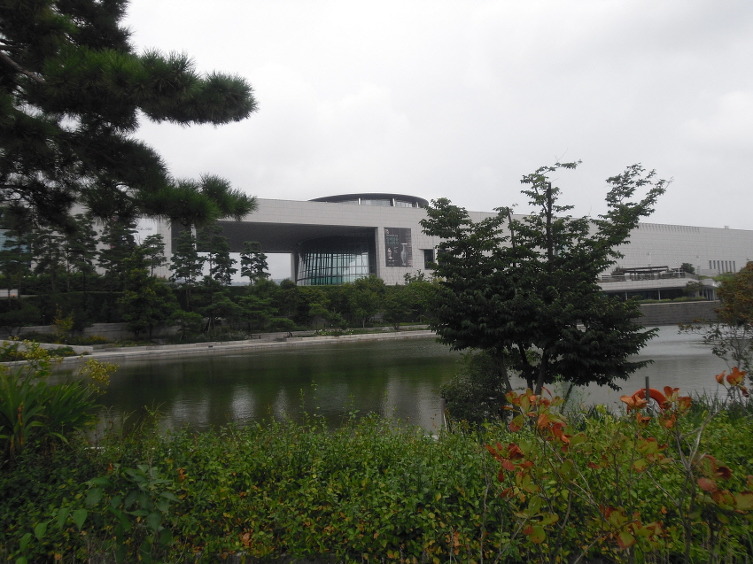
Modern Interpretation of Traditional Architecture
The basic concept of the new museum is to reinterpret traditional architectural spirit of Korea in a contemporary way. An open plaza is to connect two separate buildings and to make them appear as one grand building. The open plaza is designed to evoke maru (wooden floor), a unique architectural element in Korea. Open to all visitors, it serves as a gateway to all other points of the museum including the exhibition halls, special gallery, and the staff office.
With Mountains Behind and Water in Front
Mountains are an indispensable part of Korean environment. Mountains and water are elements of harmony and balance together like yin and yang, and generate prosperity and stability. In accordance with traditional architecture, the museum building is located deep inside from the boundary of the lot: the museum face south and has mountains behind and water in front.
Harmony between the Natural Park and the Cultural Complex
The pond in the center of the building site, the outdoor exhibition area, and the rest of the facilities are harmoniously arranged at the core of the museum architecture. The natural scenery of Yongsan Family Park provides a graceful setting for the museum building. Falls, streams, and green areas have been cultivated to create a useful and yet refined cultural space.
Disposition of Buildings with the Development of Central Axis of Seoul in Mind
A secondary gate has been planned at the northern site of the National Museum of Korea in preparation for the development of the Yongsan area, which will be part of the central axis of Seoul once the US military base is moved. The architectural plan has a symbolic significance as it will make the National Museum of Korea the center of the first museum complex in Korea.
Posted: March 11th, 2010 | Author: nat | Filed under: architecture | Tags: Moca | 1 Comment »
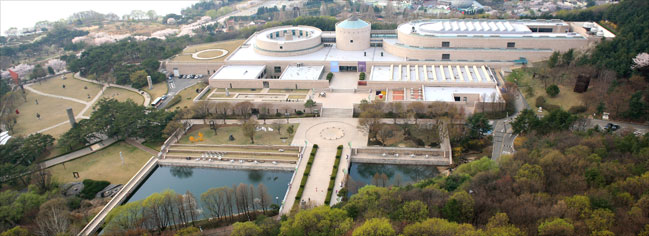
The museum building was constructed in a manner that harmonizes with both the natural and the artificial beauty of its surroundings, through a traditional form that invokes contemporary tastes.
The design of the museum reflects Korea’s traditional architectural style of fortress walls and a beacon mound. The museum features a sculpture gallery in the form of fortress walls, a painting gallery the shape of a semi-oval hall, and the Ramp Core in the style of a beacon mound that connects the two sections.
With the aim of providing a more consistent and convenient exhibition space, the Ramp Core is located at the center of the museum, and the sculpture exhibitions and painting exhibitions are positioned to the left and right of the Ramp Core. Visitors can reach each gallery by following the slanted slope of the Core.
The exterior space of the museum is designed to reflect a traditional Korean garden, enabling gradual access through a passage that gives the visual effect of a steady ascent. The sculpture garden is formed naturally by the shape of the surrounding land and the trees and shrubs.
The passageway, which starts from the south wall of the museum and navigates separately from the main road around the ravine, gives a sense of mysticism and calmness through the change in scenery and the hidden traditional houses.
The main exterior material is a light pink Korean granite, which is well-harmonized with the characteristics of the wooden material and the calm and stable form of the building. The museum has a traditional image that blends in well with the surrounding landscape. Fully equipped with modern facilities, scientific equipment and various installations, the museum is more than equal to the task of being the only national contemporary art museum in Korea.
Text from http://www.moca.go.kr/
Posted: March 10th, 2010 | Author: nat | Filed under: architecture | No Comments »
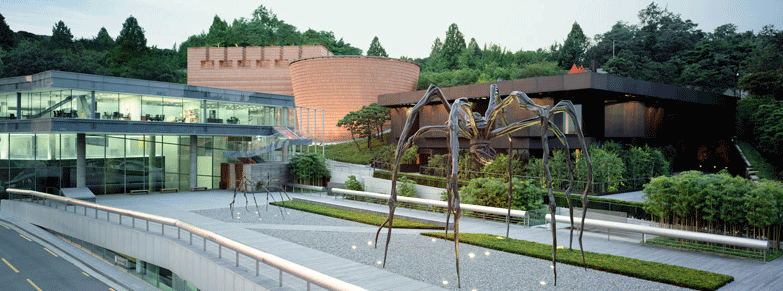
Leeum, Cultural Complex Designed by Three Architects of the World
Located on the slopes of the Namsan Mountain in Hannam-dong and flanked by the Hangang River, the Leeum complex is the optimal synthesis of nature and architecture. The complex is split into three major parts by three different internationally acclaimed architects. MUSEUM 1, which will house the Korean Traditional Art collection, has been designed by the Swiss architect, Mario Botta. MUSEUM 2, which is connected to MUSEUM 1, will house the Contemporary Art collection and has been designed by the French architect, Jean Nouvel. Along with Samsung Child Education & Culture Center by the Dutch architect Rem Koolhaas, these three works of contemporary architecture will create a cultural complex where these individual architectural masterpieces will be brought together to create a complementary and harmonious whole.
MUSEUM 1 for Korean Traditional Art and MUSEUM 2 for Contemporary Art collectively occupy a site of some 4,000 with a total floor area of 15,000. The Samsung Child Education & Culture Center, located at the entrance of Leeum, is sited in an area of 4,000 with a total floor area of 13,000. This Center will house educational facilities in the arts for children. Each of the three buildings will use a diverse material palette and innovative approaches to architectural design, reflecting the individuality of each of its designers. Their specific design contributions have created a unique cultural complex that will be an international architectural destination. Mario Bottas solid forms of terracotta, symbolizing earth and fire, bring together traditional and contemporary sensibilities. Jean Nouvels innovative use of glass and steel reflect a highly contemporary attitude and Rem Koolhaas black concrete structure, creates an abstract space and makes a bold statement about his future of architecture.
 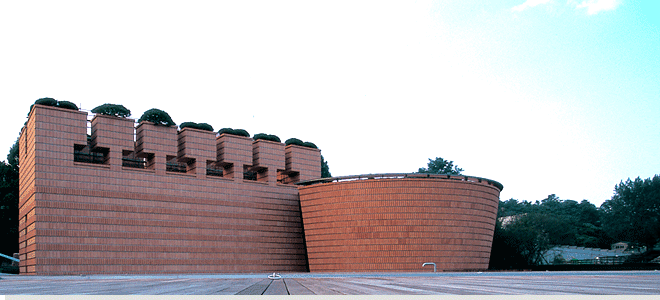
MUSEUM 1 Conveying Sublime Visual Capacity of Leeum

Mario Botta believes that museums should play a similar role to the religious buildings of the past. As houses of culture, he believes they should inspire solemnity and dignity.
MUSEUM 1 is a minimal but massive hexahedron & inverted cone on the slope of Namsan Mountain set against the backdrop of the Hangang River. This intersection of these powerful geometric volumes has symbolic value. The reverse cone mass marks a powerful threshold allowing people to enter underground crossing the southern road. The rooftop of the building evokes the battlements of old fortifications, taking us back to an image of ancient Seoul. Bottas building sits in stark contrast to the robust horizontal platform by Rem Koolhaas, which is also different from heavy mass by Jean Nouvel.
His proposal for stark and simple rectangular forms and reverse conical shapes produce a fortress-like quality, protecting the traditions that the museum houses. The exterior terracotta walls are a metaphor for Korean porcelain since both materials are created from earth and fire. The use of this material recalls traditional Korean earthenware, which constitutes many of the exhibition items. The respect for tradition is expressed by Botta distinctively with the geometrical symbolic volumes and stylized exterior wall at Leeum.
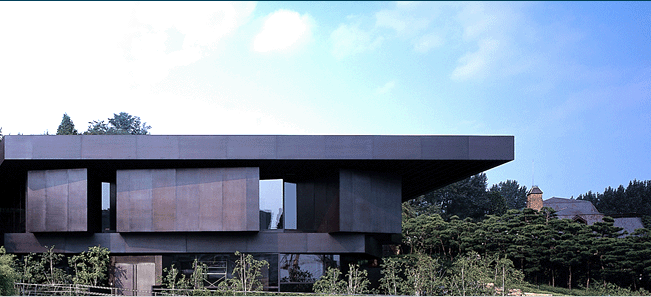 Â
Â
Sensuous Architecture Employing Progressive Technology and Materials

Jean Nouvels work is positioned at the intersection of state-of-the-art technological innovation and contemporary aesthetic practice, rendering his work both radical and provocative. Nouvel defines architecture as both ‘the technique of organizing space and the technique of creating an image. MUSEUM 2 of Leeum reflects his design philosophy.
MUSEUM 2 integrates itself into the natural landscape while remaining an autonomous contemporary art object in its own right. MUSEUM 2 for contemporary art collection is composed of rectangular ‘exhibition boxes’ of various sizes. These boxes are arranged in a seemingly loose manner to create a random-like arrangement, giving viewers a sense of surprise in each unique individual exhibition spaces. While programmatically well choreographed and highly organized the random-like arrangement of exhibition boxes gives the building an interesting form, which is integrated well with the site. MUSEUM 2 was designed to house the diverse collections of the Samsung Foundation of Culture. MUSEUM 2 will not only exhibit important works of Korean Modern artists but internationally renowned artists such as Donald Judd, Damien Hirst and Andy Warhol.
MUSEUM 2 contains conference facilities and office spaces in addition to the exhibition spaces. The viewers enter the MUSEUM 2 through the lobby of MUSEUM 1. The material for the exhibition boxes is rusted stainless steel, which is being used as building material for this project for the first time in the world. This new material, rusted stainless steal, has been researched through numerous testing processes, to ensure the process of natural rusting of the building over time will render the building itself to a progressive icon of contemporary art in an urban context.
Text from http://www.leeum.org/
Posted: March 10th, 2010 | Author: nat | Filed under: architecture | Tags: Rem Koolhaas & OMA moa | 1 Comment »
ARCHITECTURE

MoA(Museum of Art , Seoul National University), located beside the university’s main gate, serves as a contact point for the university and the local community. With U-glass exteriors and steel-framed trusses, the architecture of the MoA features a unique design that resembles a gigantic sculptural work floating in the air.
The interior of the MoA, with the floor area of 4,486.47 m2, consists of three stories and three underground levels. The dynamic spiral passage in the center connects the wings on two sides making the museum an open cultural space. The Museum’s entire structural design, the likes of which are rarely seen in Korea, organically connects exhibition spaces, educational spaces, and various other amenities like an archive room and a lounge.
â–ª Building Area: 2,775.56 m2
â–ª Gross Floor Area: 4,486.47 m2
â–ª Height: 17.575 m
â–ª Structure: Steel-framed trusses, ferroconcrete
â–ª Exterior finishing: U-Glass System
â–ª Designer: Rem Koolhaas
â–ª Supervisor: Office for Metropolitan Architecture (OMA), Samoo Architects & Engineers, Co., Ltd.
â–ª Builder: Architecture Division, Samsung Corporation
Rem Koolhaas & OMA : .
Creators of a new paradigm in urban structural design and architecture
Rem Koolhaas, the designer of the MoA, is an internationally renowned and influential architect not only in the field of modern architectural design but also in architectural theory. He took up architecture at the Architectural Association School of Architecture in London and worked for the Institute for Architecture and Urban Studies in New York. In addition, he wrote several seminal books on architectural theory, including Delirious New York (1978), which is considered a classic volume on modern and contemporary architecture and society. He was the recipient of the Pritzker Architecture Prize in 2000, often called the “Nobel Prize in Architecture.†The Office for Metropolitan Architecture (OMA), which he established in London in 1975, has its offices in Rotterdam, New York, and Beijing and is expanding its business not only in Europe but also in USA and Asia.
Some of his major designs include buildings such as the Netherlands Dance Theatre in the Hague, Kunsthal in Rotterdam, Los Angeles Museum, and Educatorium in Utrecht, as well as housing designs like the Nexus Housing in Fukuoka, Japan, Maison à Bordeaux in France, and The Dutch House in the Netherlands. His recent works are the Netherlands Embassy in Berlin and the Seattle Central Library in the USA. He also took charge of the expansion and the interior design for Prada stores in Manhattan, New York, and Los Angeles. He also participated in the design of Leeum, Samsung Museum of Art.
Professor in Practice of Architecture and Urban Design at Harvard University’s Graduate School of Design, Rem Koolhaas has been researching various issues that influence urban environments. His architectural design neither depends on any one trend nor advocates an identical style. In every design, his use of space is notably free, variable, and divided into various pieces depending on functions.
Text from  http://www.snumoa.org/
Posted: March 10th, 2010 | Author: nat | Filed under: Uncategorized | No Comments »

Posted: March 10th, 2010 | Author: nat | Filed under: Uncategorized | No Comments »
Â
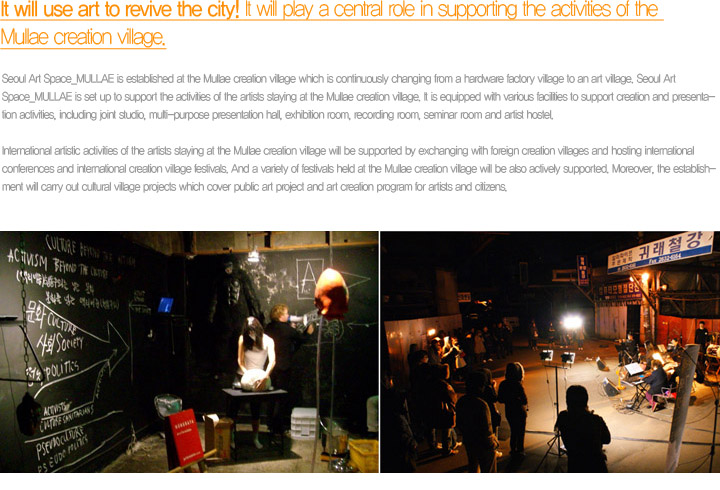

Posted: March 10th, 2010 | Author: nat | Filed under: Uncategorized | No Comments »











